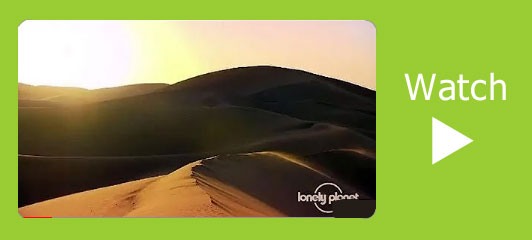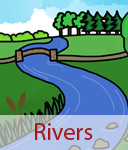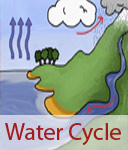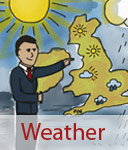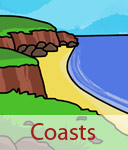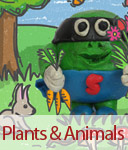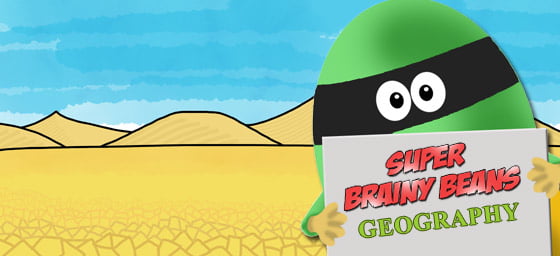
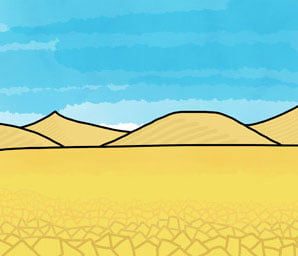
Deserts and drought
Deserts and drought for kids KS2. Primary homework help with what is a desert, desert climates, droughts and famine.
What is a desert?
Deserts are large, dry areas of land that get very little rain each year—usually less than 25 cm (10 inches). Because of this, deserts are some of the driest places on Earth. They can look very different: some have endless stretches of sand dunes, while others are rocky, with mountains and cliffs.
Very few people live in deserts because life there can be very hard. The extreme temperatures, lack of water, and limited shelter make it difficult for humans, animals, and plants to survive. However, some people, called nomads, have learned to adapt and move around the desert with their animals in search of food and water.
There are two main types of desert:
- Hot deserts – These are found near the equator, like the Sahara Desert in Africa. They have scorching daytime temperatures, but nights can be surprisingly cold.
- Cold deserts – These are found nearer the poles, like the Gobi Desert in Asia or Antarctica. Instead of blazing heat, they are dry, icy, and very windy.
Even though deserts seem empty, many amazing animals and plants have adapted to survive there, such as camels, cacti, and desert foxes.

What is the weather like in a desert?
The weather in deserts is some of the most extreme in the world! During the day, deserts can get incredibly hot. In places like the Sahara, temperatures can rise up to 52°C (126°F) or even higher. The sun beats down with no shade, and the dry air makes it feel even hotter.
But deserts don’t stay hot all the time. At night, the temperature can drop very quickly. Because there are no clouds to trap the heat, all the warmth from the ground escapes into the sky. This makes deserts freezing cold after sunset, sometimes going below 0°C (32°F). Imagine going from boiling hot to icy cold in just a few hours!
Deserts also get very little rain—sometimes no rain at all for months or even years. When it does rain, it often comes as short, violent storms with thunder and lightning. The dry, hard ground cannot soak up the water quickly, so instead of sinking in, the rainwater rushes across the surface, creating flash floods. These sudden floods can be very dangerous, but they also bring life to the desert by filling rivers and watering plants.
Because of these extreme changes in temperature and sudden bursts of rain, animals and plants in the desert have had to adapt in amazing ways to survive.
 Fun Desert Facts
Fun Desert FactsCheck out our fun desert facts for kids and enjoy learning a variety of interesting information about deserts.
 Desert Facts For Kids
Desert Facts For KidsAccording to an estimate, deserts receive no more than 250 mm of rain annually. Check out all these amazing desert facts.
What is the desert landscape like?
When people think of deserts, they often imagine endless golden sand, like in the movies. But in reality, most deserts don’t look like that! In fact, only about 25% of the world’s deserts are sandy. The rest are made up of rocky ground, gravel, dry earth, and sometimes even tall, rugged mountains.
The sandy deserts that do exist are full of sand dunes. These are large hills of sand that are shaped by the wind. Dunes are always changing—the wind pushes the sand so the dunes move slowly over time, and their shape can look different each day. Some dunes are small, while others can grow as tall as skyscrapers!
Deserts are also shaped by erosion, which happens when strong winds blow sand against rocks. Over thousands of years, this wears away the rock, carving out strange and beautiful shapes like arches, towers, and cliffs. These natural sculptures make desert landscapes look very dramatic and unique.
Sometimes, when the wind is really powerful, it creates sandstorms. These storms pick up huge amounts of sand and dust and carry them through the air, making it hard to see or breathe. Even though sandstorms can be dangerous, they are also part of what makes deserts so special.
- Some deserts have “singing sand dunes”—they make a humming sound when the sand slides down.
- The tallest sand dunes in the world are in Namibia—they can be over 300 metres high, taller than the Eiffel Tower!
How do plants and animals survive in the desert?
Living in the desert is tough because there is very little water and the weather is extreme. But plants and animals have developed amazing ways to survive!
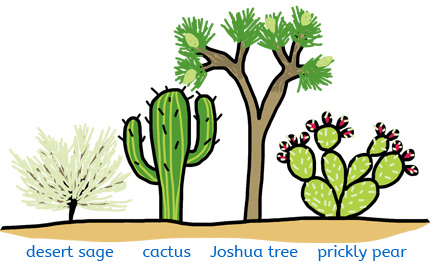
Plants
- Many desert plants have shallow roots that spread out wide to quickly soak up rain before it disappears into the ground.
- Others, like cacti, have thick stems or trunks that store water like a sponge.
- Their waxy coating helps stop the water from escaping.
- Most desert plants have tiny or no leaves to reduce water loss. Some even grow spines instead of leaves, which also protect them from animals.
- Some plants have seeds that can stay asleep in dry soil for years, only growing when rain finally comes.
Examples: Cactus, Joshua tree, prickly pear, and desert sage.
Animals
- Desert animals often get their water from the food they eat, like juicy plants or prey.
- To save water and energy, many animals stay hidden in cool, shady places during the hot daytime and come out at night when it’s cooler—this is called being nocturnal.
- Camels are famous desert animals because they can go for days without drinking, storing fat in their humps which can be turned into energy and water.
Examples: Camels, fennec foxes, scorpions, snakes, lizards, and roadrunners.
- A camel’s hump doesn’t hold water—it stores fat, which the camel’s body can turn into energy and water.
- Fennec foxes have big ears that keep them cool by releasing heat.
- The Saguaro cactus can hold up to 4,000 litres of water, enough to fill a small swimming pool!
What is an oasis?
An oasis is like a green island in the middle of a dry desert. It is a place where underground water comes close to the surface and forms a pool, lake, or spring.
At an oasis, plants such as palm trees, grasses, and crops can grow, making it a vital place for both animals and people to gather for food, shade, and water. Many desert towns and villages are built near oases because they provide life in an otherwise dry and empty landscape.
Some large oases even support farms, where people can grow crops such as dates, olives, or wheat. They become centres of trade and travel, as travellers and caravans stop at oases to rest and refuel.
Famous deserts of the world
Deserts cover about one-third of the Earth’s surface, and each one is unique. Here are some of the most famous deserts in the world:

The Sahara Desert, Africa
-
- The largest hot desert in the world, covering 9 million km²—about the size of the United States!
- Temperatures can reach over 50°C (122°F) during the day.
- Home to camels, fennec foxes, and desert nomads who travel across it.
The Gobi Desert, Asia
- A cold desert that stretches across China and Mongolia.
- Famous for its rocky landscape and freezing winters.
- Dinosaurs once lived here—many fossils have been found!
The Atacama Desert, South America
- Found in Chile, it is the driest desert in the world.
- Some places in the Atacama have not had rain for hundreds of years.
- Scientists study it because it looks similar to the surface of Mars.
The Kalahari Desert, Africa
- Covers parts of Botswana, Namibia, and South Africa.
- Not as dry as other deserts—sometimes it gets enough rain to support plants, animals, and people.
- Home to lions, meerkats, and the San people, one of the oldest cultures in the world.
The Great Victoria Desert, Australia
- The largest desert in Australia.
- Has red sand, spinifex grass, and is home to lizards, snakes, and dingoes.
- Extremely remote—very few people live here.
Antarctica, South Pole
- The largest desert on Earth, but a cold one.
- Covered in ice, with penguins, seals, and whales living near its coasts.
- Some areas haven’t seen rain or snow for millions of years!
Antarctica Desert
You might be surprised, but Antarctica is actually the largest desert in the world—and it’s a cold desert!
Where is it?
Antarctica lies at the South Pole. It is the coldest, driest, and windiest place on Earth. Some parts haven’t had rain or snow for millions of years, making it drier than the Sahara.
Animals and Plants
Very few plants can survive here—only mosses, lichens, and algae. But some hardy animals thrive along the coast, including penguins, seals, whales, and seabirds. In the icy waters around Antarctica, tiny creatures called krill form the base of the food chain.
How humans and animals survive
Animals survive the freezing temperatures with thick layers of fat (blubber) or warm feathers/fur.
People do not live permanently in Antarctica, but scientists stay at research stations. They survive using special insulated clothing, heated buildings, and supplies brought from other countries.
Weather
Antarctica can be as cold as -89°C, with strong winds and blizzards. The sun does not rise at all during winter (months of darkness), and in summer the sun never sets (24-hour daylight).
Climate Change
Antarctica is now one of the places most affected by climate change. Ice sheets and glaciers are melting, causing sea levels around the world to rise. This threatens not only Antarctic wildlife, such as penguins losing breeding grounds, but also people and cities far away on other continents.
- Antarctica is the windiest place on Earth—winds can blow over 200 mph!
- Emperor penguins are the only animals that stay on Antarctica’s ice during the freezing winter.
- The ice sheet in Antarctica is so thick that if it melted, sea levels worldwide would rise by 60 metres.
 Fun Antarctica Facts
Fun Antarctica FactsBecause it experiences such little rain, Antarctica is considered a desert. Check out these facts about Antarctica.
 Antarctica Facts For Kids
Antarctica Facts For KidsDiscover this magnificent continent through these interesting Antarctica facts for kids.
What is a drought?
A drought happens when there is very little or no rain for a long time. The land dries out, rivers and lakes shrink, and the soil becomes so hard and cracked that plants can’t grow.
Impact on plants and animals
- Plants wilt and die without enough water.
- Animals struggle to find food and water, which may force them to move to other areas.
- Some animals, like cattle or goats, can die in large numbers during long droughts.
Impact on humans
- Farmers cannot grow enough food, leading to shortages.
- People may have to travel long distances to find clean water.
- Health problems can increase when there is little water for drinking or washing.
Can we prevent droughts?
We cannot stop droughts from happening, but we can reduce their impact. People can:
- Store rainwater in reservoirs.
- Use water carefully and avoid waste.
- Grow crops that need less water.
- Plant trees to help keep soil moist.
 CBBC Newsround - Drought
CBBC Newsround - DroughtNewsround's Ricky has been out to Kenya to report on the drought in East Africa, and what it means for the people who live there.
 CBBC Newsround - The Children of drought
CBBC Newsround - The Children of droughtWatch Children of the Drought: A Newsround Special.
 Drought for kids
Drought for kidsWhat is drought? We'll explore weather, climate, and the water cycle to understand drought better.
 Just a Drop
Just a DropJust a Drop is an international water aid charity. To date, we have provided clean, safe water to some of the poorest communities in over 30 countries worldwide.
What is a famine?
A famine happens when there isn’t enough food for everyone to survive. Drought is one of the main causes of famine, but war, poverty, and poor farming conditions can make it worse.
Impact on people
- People do not get enough to eat and may become weak or ill.
- Children suffer most in famines, as they need food to grow and stay healthy.
- Families may be forced to leave their homes in search of food, creating refugees.
How can we prevent famine?
- Provide emergency food supplies to people in need.
- Improve farming methods to help communities grow more crops.
- Store extra food and water during good years, so it’s available during dry years.
- Share food fairly and peacefully between countries.
Helping today
There are still parts of the world suffering from famine today, especially in places where drought and conflict combine. International charities and aid organisations work to send food, medicine, and clean water to help save lives.
 Guide: What does famine mean?
Guide: What does famine mean?The 'Horn of Africa' area is suffering its worst drought in 60 years. But what does the term 'famine' mean?
 Famine - Kids Britannica
Famine - Kids BritannicaWhat is famine? Learn why it can start and the effects it has on people.
 Oxfam
OxfamDroughts and floods are becoming increasingly frequent. It means that millions of people are going hungry. See what Oxfam is doing to help.

